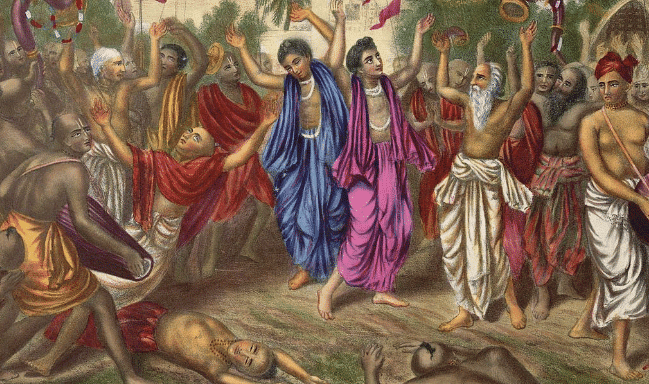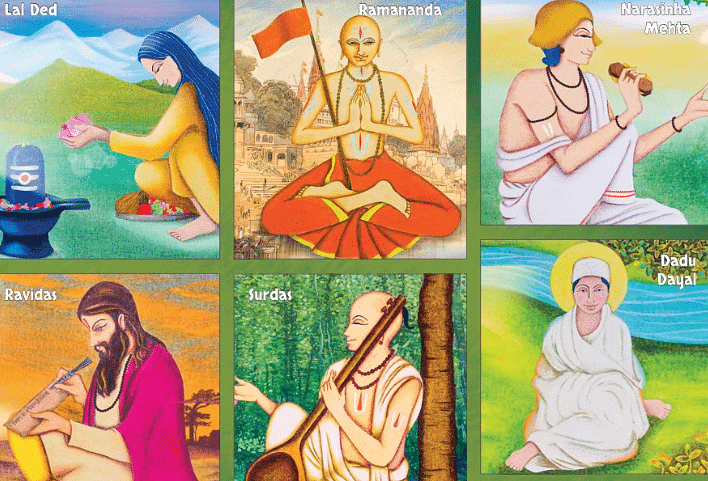Nitin Singhania Summary: Bhakti and Sufi Movements | History for UPSC CSE PDF Download
Origin of the Bhakti Movement
The Bhakti movement, which emerged between the 6th and 10th century AD, had its origins in the Southern regions of India, particularly Tamil Nadu. Its influence gradually extended northwards, gaining prominence from the late 15th century onward.
 Origin of Bhakti Movement
Origin of Bhakti Movement
Causes for the Emergence of Bhakti Movement
- The Bhakti movement arose as a response to the inflexible Brahmanical orthodoxy and caste system rigidity.
- It served as an inclusive platform, emphasizing the equality of mankind, particularly appealing to underprivileged sections of society.
- Stagnation and decline in Buddhism and Jainism contributed to disenchantment, creating room for a new religious thought based on devotion.
 Bhakti Movement
Bhakti Movement
- Royal patronage, exemplified by the support from Chola kings in Tamil Nadu, played a significant role in fostering the Bhakti movement.
- The presence of Bhakti saints, such as the Nayanars (Shiva devotees) and Alvars (Vishnu devotees) in South India, preached devotion to God, disregarding the austerities of Buddhism and Jainism.
- The use of vernacular languages like Tamil and Telugu made the teachings of Bhakti saints accessible to the common people.
- The Bhakti tradition did not necessitate the presence of priests, contributing to the widespread popularity of the movement.
Major Features of the Bhakti Movement
- The Bhakti movement emphasized intense love and devotion as a means of salvation.
- It advocated the unity of God (Universalism) and the repetition of the One True Name.
- The movement rejected rituals and ceremonies in favor of a more direct and personal connection with the divine.
- Bhakti promoted equality, rejecting caste discrimination, and maintaining an open-minded stance on religious and gender issues.
 Indian Bhakti Saints
Indian Bhakti Saints
- The use of local languages for communication made the Bhakti messages easily accessible to the common people.
- Bhakti stressed the idea of a personal God and highlighted the importance of a true Guru for realizing God.
- The movement propagated the concepts of equality and brotherhood, similar to the ideals of Sufis.
- Bhakti saints despised priestly intermediaries, preferring a direct connection with God.
 |
Download the notes
Nitin Singhania Summary: Bhakti and Sufi Movements
|
Download as PDF |
Two Schools of Bhakti: Saguna and Nirguna
- The Nirguna School of Bhakti envisioned God as formless with no attributes, rejecting scriptures and idol worship. Prominent figures in this school included Kabir, Guru Nanak, and Dadu Dayal.
- The Saguna School of Bhakti perceived God as having definite positive attributes, believing in incarnations such as Rama and Krishna. This school, divided into Ram Bhakti and Krishna Bhakti groups, accepted the spiritual authority of Vedas and advocated idol worship. Notable figures in this school were Ramanuja, Ramananda, and Chaitanya Mahaprabhu.
 Guru Nanak Dev Ji
Guru Nanak Dev Ji
Women in the Bhakti Movement
Women played a significant role in the Bhakti movement, facing struggles for acceptance in the male-dominated environment.
Female saints rejected traditional societal norms, with some leaving home for their devotion while others participated in the Bhakti movement within their households.
Important Female Saints:
Mirabai:
- From a ruling Rajput family, she treated Lord Krishna as her husband and expressed her devotion through poems.
- Notable composition: ‘Paayoji Maine Ram Ratan Dhan Paayo.’
Akka Mahadevi:
- A 12th-century bhakt known as 'Akka,' devoted to Lord Shiva.
- Acknowledged as an elder sister by great philosophers Madivalayya and Chenna Basavanna.
 Akka Mahadevi
Akka Mahadevi
Janabai:
- Coming from the Shudra caste, she worked in the household of saint Namdeva.
- Despite lacking formal education, she composed over 300 poems, reflecting her life experiences.
Bahina: A 17th-century poet-saint from Maharashtra, she wrote abhangas depicting the working life of women, particularly in the fields.
Andal: The only female Alvar, expressing unconditional love for Lord Vishnu through her poems.
Bhakti Literature and its Contribution to Indian Culture
Nature of Bhakti Literature:
- Extreme devotion is expressed by devotees surrendering themselves to God.
- Composed mainly in vernacular languages for accessibility.
- An unorthodox approach emphasizing an intimate relationship with God.
- Secular, non-sectarian, and tolerant, fostering religious harmony.
Contribution of Bhakti Literature to Indian Culture:
- Encouraged improved ethical values such as compassion, non-violence, and righteous living.
- Contributed to the preservation and development of local languages, maintaining linguistic diversity.
- Enriched culture by influencing arts like music (Kirtana, Qawwall), dance (Sattarlya), and paintings with devotional themes.
- Played a role in breaking barriers of caste, creed, and social status, promoting unity and inclusivity.
 Lord Shiva
Lord Shiva
Impact of the Bhakti Movement:
Upliftment of Women and Lower Strata: The Bhakti movement uplifted the position of women and members of the lower strata in society.
Language Development: Preachers of the Bhakti movement spoke and wrote in regional languages, contributing to the development of Hindi, Marathi, Bengali, Kannada, etc.
Philosophy of Charity and Service: The movement led to the development of a new philosophy emphasizing a life of charity and service to fellow human beings.
Synthesis of Bhakti and Sufism: The synthesis of Bhakti tradition and Sufism fostered unity among Hindu and Muslim communities.
The Sufi Movement
Origin
- Sufism, the mystical aspect of Islam (tasawwuf), emphasizes self-realization, tolerance, righteousness, and universal love.
- The term 'Sufism' is rooted in the Arabic word for wool (suf), denoting the rough wool garments worn by ascetics and prophets.
- Sometimes traced to the Arabic word 'safa,' meaning purity.
- Sufi movement in India started around 1300 AD and reached South India in the 15th century.
 Pir-Murshidie tradition
Pir-Murshidie tradition
Characteristics
- Sufis aimed at purifying their inner selves through introspection and mental struggle to attain ikhlas (absolute purity of intention and acts).
- Recognized the need for intuitive knowledge beyond outward sciences.
- Strictly followed the Pir-Murshidie tradition (similar to the Guru-Shishya tradition).
- The ultimate goal of Sufism is union with God.
- Love of God is equated to love towards humanity; service to humanity seen as service to God.
- Inculcated a spirit of tolerance among followers.
Different Sufi Orders in India
- Sufis are organized into orders or 'silsilahs,' categorized into 'Be-shara' (against Sharia law) and 'Ba-shara' (in favor of Sharia law).
- Prominent silsilahs or Sufi orders include Chishti, Suhrawardi, Firdausi, Qadariya, Nagshbandj, etc.
- Be-shara, known as 'Mast Kalandars/Malangs/Haidaris,' rejected Sharia law, were wanderers, and were commonly called 'babas.'
 Sufism
Sufism
A. Chishti Silsilah:
- Founded by Khwaja Moinuddin Chishti in India, emphasizing service to the poorest sections of society.
- Philosophy is based on 'panthetic monoism' (Wahdat-al-wujud), similar to Vedantic philosophy.
- Notable Sufi saints include Qutbuddin Bakhtiyar Kaki, Sheikh Salim Chishti, Fariduddin Ganjshakar, Sheikh Nizamuddin Auliya, Sheikh Nasiruddin Mahmud, Sheikh Hamiduddin of Nagaur, Sheikh Burhanuddin Gharib.
- Chishti literature includes 'Awarif al-Ma'arif' and 'Kashf al-Mahjub.'
B. Suhrawardi Silsilah:
- Founded by Sheikh Shihabuddin Suhrawardi, and established in India by Sheikh Bahauddin Zakariya.
- Stressed ownership of three attributes: property, knowledge, and mystical enlightenment.
- Observed religious rituals and advocated the fusion of mysticism and scholarship.
- Rejecting some Chisti practices, it became popular in Punjab, Sindh, Kashmir, and parts of Bengal.
C. Qadiriyya Silsilah
- Introduced by Shah Nimatullah, gained popularity in Punjab, especially Sindh.
- Pirs of this order supported the concept of Wahadat al-wujud.
- Influential pirs include Miyan Mir, and followers include Prince Dara Shikoh, Hasrat Mohani, and Muhammad Iqbal.
D. Naqshbandi Silsilah:
- Established by Khwaja Baha-ud-Din Nagshband, with Ahmad Sirhindi as a notable saint.
- Gained popularity during the reign of Akbar and had Aurangzeb as one of its followers.
 Sheikh Sirajuddin Abdullah Shattar
Sheikh Sirajuddin Abdullah Shattar
E. Shattari Silsilah:
- Established by Sheikh Sirajuddin Abdullah Shattar, popular in Malwa, Jaunpur, and Bengal.
- Tansen, the legendary musician of Akbar's court, was a follower of this order.
F. Kubrawiya Order:
- Founded by Najm-ad-Din Kubra, known as Firdausia Silsilah.
- Popular in Eastern India, Bangladesh, and Mauritius.
Impact of Sufism
- Bridged the gap between Hindu and Muslim communities, fostering closer relations.
- Took root in both rural and urban areas, exerting deep social, political, and cultural influence.
- Aimed to bring peace and harmony, influencing the masses positively.
|
113 videos|550 docs|173 tests
|
FAQs on Nitin Singhania Summary: Bhakti and Sufi Movements - History for UPSC CSE
| 1. What is the origin of the Bhakti Movement? |  |
| 2. What were the key beliefs of the Bhakti Movement? |  |
| 3. How did the Bhakti Movement impact society? |  |
| 4. Who were some notable Bhakti saints during this movement? |  |
| 5. How did the Bhakti Movement influence subsequent religious and social movements in India? |  |

























